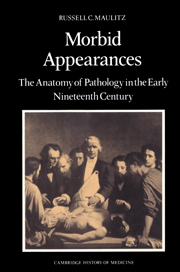Book contents
- Frontmatter
- Contents
- Dedication
- Preface
- Introduction: Ouverture: Bichat's head
- PART ONE PARIS
- 1 Genesis of a tradition
- 2 Pathology and the Paris faculty
- 3 Pathology in the middle
- 4 The center holds
- PART TWO CHANNEL CROSSING
- PART THREE LONDON
- Conclusion: A language of morbid appearances
- Appendix: Transcription and translation of Figure 1.1
- Notes
- Selected bibliography
- Index
2 - Pathology and the Paris faculty
Published online by Cambridge University Press: 22 September 2009
- Frontmatter
- Contents
- Dedication
- Preface
- Introduction: Ouverture: Bichat's head
- PART ONE PARIS
- 1 Genesis of a tradition
- 2 Pathology and the Paris faculty
- 3 Pathology in the middle
- 4 The center holds
- PART TWO CHANNEL CROSSING
- PART THREE LONDON
- Conclusion: A language of morbid appearances
- Appendix: Transcription and translation of Figure 1.1
- Notes
- Selected bibliography
- Index
Summary
BICHAT AND THE ECOLE PRATIQUE
Had Xavier Bichat been chosen, in the early summer of 1799, for the official teaching position in what was now designated the Ecole de médecine, he would have been suddenly thrust into a pivotal position in the school's new program. The death of Honore Fragonard (1732–99) had vacated the post of chef des travaux anatomiques in the faculty's recently annexed Ecole pratique. The physicians of the School had welcomed the subsidiary institution “into their bosom” in 1795, when the new, more ecumenical, academic regime began in earnest: Physicians and surgeons now toiled under a single institutional roof.
Since that first year Fragonard had been chef, directing a staff of prosecteurs that included André Duméril (1774–1860) and Guillaume Dupuytren (1777–1835). Both were capable young surgeons and accomplished anatomists. Later in the Napoleonic period, Dupuytren would become known as a dominant figure in his own right (Chapter 3). Though anxious to gain entry to the inner sanctum of the Ecole staff, Bichat no doubt recognized the likelihood that one of the two prosectors already in place, even though they were both considerably his juniors, would ultimately be named to succeed Fragonard, competitive concours or not. At the end of June, Bichat dropped out of the running.
- Type
- Chapter
- Information
- Morbid AppearancesThe Anatomy of Pathology in the Early Nineteenth Century, pp. 36 - 59Publisher: Cambridge University PressPrint publication year: 1987

